
About UsThe Numismatic Bibliomania Society is a non-profit organization promoting numismatic literature. For more information please see our web site at coinbooks.org SubscriptionsThose wishing to become new E-Sylum subscribers (or wishing to Unsubscribe) can go to the following web page link MembershipThere is a membership application available on the web site Membership Application To join, print the application and return it with your check to the address printed on the application. Membership is only $15 to addresses in the U.S., $20 for First Class mail, and $25 elsewhere. For those without web access, write to: David M. Sundman, Secretary/TreasurerNumismatic Bibliomania
Society AsylumFor Asylum mailing address changes and other membership questions, contact David at this email address: dsundman@LittletonCoin.com SubmissionsTo submit items for publication in The E-Sylum, just Reply to this message, or write to the Editor at this address: whomren@coinlibrary.com
BUY THE BOOK BEFORE THE COINYou won't regret it! |
- WAYNE'S WORDS: THE E-SYLUM JUNE 1, 2008
- WIDE(ER) LOAD AHEAD: THE E-SYLUM BROADENS ITS STANCE
- WIZARD COIN SUPPLY LAUNCHES BOOK ADVISORY
- MORE ON THE 100 GREATEST WORKS OF AMERICAN NUMISMATIC LITERATURE
- PHOTO ARCHIVE: NUMISMATIC BIBLIOPHILES VISIT CARNEGIE LIBRARY RARE BOOK ROOM
- R.E. NAFTZGER, JR. 1925-2007
- 'COIN NEWS' OF THE UNITED KINGDOM IS NOW AVAILABLE ONLINE
- MORE NOTES ON ERIC NEWMAN
- MORE ON THOSE OBVERSE MARKS ON A FEW 1794 DOLLARS?
- QUERY: WHAT IS THE SIGNIFICANCE OF ROYAL MINT DIE NUMBERS?
- QUERY: DON TAXAY COIN WORLD ARTICLE SOUGHT
- U.S. MARINE IN IRAQ SUSPENDED OVER TOKENS QUOTING GOSPEL
- UNUSUAL COIN FOUND ON FLORIDA BEACH
- TOP INVESTOR STARTED BY BUYING SILVER DOLLARS
- WALL STREET JOURNAL ON USED MEDALS FROM THE OLYMPIC DOPING SCANDALS
- NEW METALS FOR COINS AND MEDALS MANUFACTURED IN SPACE?
- THE CASE OF THE BOGUS BORDEAUX
- U.S. MINT EMPLOYEE DISCIPLINED FOR PUTTING OWN FACE ON NICKELS
- FEATURED WEB SITE: GERMAN NOTES
WAYNE'S WORDS: THE E-SYLUM JUNE 1, 2008
 Among our recent subscribers are David
Hirsch, Scott Barnes and Leroy Smith. Welcome aboard! We now have 1,141
subscribers.
Among our recent subscribers are David
Hirsch, Scott Barnes and Leroy Smith. Welcome aboard! We now have 1,141
subscribers.This week we have another improvement to our weekly email format. We still have some bugs to work out, but we're getting there. Thanks for all your comments and support while we work through the problems.
In this issue I make a few nominations of my own for the 100 Greatest Works of American Numismatic Literature, and discuss a couple photos of the 1989 ANA convention.
In the news, numismatists are just now learning of the October 2007 death of a titan in the realm of American numismatics, the UK's 'Coin News' is available online, and a U.S. Marine gets in trouble for distributing a private token.
To learn how an Olympic athlete can win a gold medal, lose it, then win it back again, read on. Have a great week, everyone.
Wayne Homren
Numismatic Bibliomania Society
WIDE(ER) LOAD AHEAD: THE E-SYLUM BROADENS ITS STANCE
Last week Ronald Thompson wrote: "Is there any way to make the new format wider? I usually don't get a chance to read the E-Sylum at my computer so I print out a copy and read it later. The narrow columns create lots of blank space. This week's edition is 38 pages!"If that's still not enough for you, Bruce Perdue offers this suggestion: "Try copying the email version by holding the left mouse button and dragging the mouse over the text to be copied and then selecting 'copy' from the right mouse button menu.... I pasted the results into 'Notepad' and made sure that word wrap was on...for last week's issue this yielded 15 pages as opposed to nearly 40 otherwise...."
Also in this issue, Dick Johnson became a pioneer by providing the first illustration for an E-Sylum numismatic book ad, and regular advertiser David Fanning followed suit. For a limited time illustrations in E-Sylum ads are free.
Thanks also to Heritage for their cataloguer position ads. Step up, E-Sylum readers - I know some of you have what it takes to leverage your numismatic libraries and research skills. Don't just collect catalogs - write some!
WIZARD COIN SUPPLY LAUNCHES BOOK ADVISORY
 Wizard Coin Supply, a global provider of coin supplies and coin collecting
accessories, is proud to announce the launch of its New Book Advisory. The
Advisory is a free service where subscribers are made aware through
periodic email notices of newly released coin books as they are added to
Wizard's inventory. The Advisory is available as an option as a seamless
part of the user registration process on Wizard's website.
Wizard Coin Supply, a global provider of coin supplies and coin collecting
accessories, is proud to announce the launch of its New Book Advisory. The
Advisory is a free service where subscribers are made aware through
periodic email notices of newly released coin books as they are added to
Wizard's inventory. The Advisory is available as an option as a seamless
part of the user registration process on Wizard's website. "At Wizard, we are determined to be the number one retailer of current release numismatic books," says Lady Karin Herndon (Wizard eschews traditional titles in favor of thematic ones). "Our new Advisory service, along with our broad selection and deeply discounted price structure, make Wizard the best choice for buyers of coin, currency and related hobby books."
Wizard currently offers nearly 300 coin book titles and is actively seeking to grow this list, giving Wizard the broadest selection of any in-print numismatic book and supply dealer in the industry. "Wizard's inventory goes beyond the popular, name brand publisher titles carried by our competitors to also include less well known books from smaller publishers and self-publishing authors. While our focus is primarily on bringing our customers in-print books at the best possible price, we also stock out-of-print books when we can obtain mint copies in quantity," says Sir Wayne Herndon who handles product selection for Wizard.
Many coin collectors and numismatic researchers building numismatic libraries will benefit from being aware of new coin books as they are issued. Even more casual collectors will find the service of interest as they can watch for books that appeal to their own personal collecting interests. Because Advisory members are contacted as soon as new books become available through Wizard Coin Supply, they are less likely to miss out on popular titles.
Wizard's entire line of numismatic books are offered at a substantial discount to the suggested retail price and Wizard guarantees lower prices won't be found through other internet retailers. New Book Advisory subscribers will get an even deeper discount on new books as they are added to the Wizard website. These discounts are exclusive to Advisory members and are not available through Wizard's other offers or advertising.
To read the complete press release, see: Leading Coin Supply Company "Wizard Coin Supply" Launches Book Advisory
As an E-Sylum book lunatic, I have to admit Ye Olde Editor is amused with Wizard's playful personnel titles.
MORE ON THE 100 GREATEST WORKS OF AMERICAN NUMISMATIC LITERATURE
Alan V. Weinberg writes: "Katie Jaeger was perfectly correct - Francis Paul Prucha's book on Indian Peace medals should have been on the 100 Greatest list and I'd have voted that in the top 35 or so. I constantly refer to it and it is three feet away from where I type in a frequently used area of my library."I'm just as guilty of not responding when the first tentative list was printed. But Len has indicated that write-ins will be considered, so I'll second the nominations mentioned here earlier and add a few of my own.
I walked thru my library shelf by shelf, choosing what I thought were highlights - books I've found extremely useful, enlightening, entertaining (or all three)! Often I checked the printed ballot and discovered my choices were already present. Here are a few that were not. Most are relatively recent publications - a book doesn’t have to be old to be great.
Phillips, Henry, Historical Sketches of the Paper Currency of the American Colonies, 1865. While Eric Newman's The Early Paper Money of America is indispensible, the Phillips work is an ideal companion, going into greater detail on the historical background of many of the note issues.
Hessler, Gene, U.S. Essay, Proof and Specimen Notes, 1979,2004. Fred Reed nominated this one but I wanted to add my appreciation for this book. Just as the Judd pattern book opened up a whole new aspect of U.S. coinage for me, Hessler's book did the same for U.S. paper money. Important research which took a tremendous amount of time and effort to compile and present, Hessler's work is mandatory for the serious numismatist.
Hancock & Spanbauer, Standard Catalog of Counterfeit and Altered United States Coins, 1979. Although long out of date and out of print, I found this book a wellspring of great information, and find myself referring to it frequently. Again, it's a book which required a great deal of time and expertise to compile, and I'm grateful to the authors. It would be on my list of "must reading" for a serious student of U.S. numismatics.
Van Ryzin, Robert, Crime of 1873: The Comstock Connection, 2001. Like another favorite already on the 100 Greatest ballot (Fractional Currency by Neil Carothers), Van Ryzin's book delves deeply into the economic and political events that gave birth to new coinages. It's a look into the "sausage factory" that despite its skullduggery and chaos manages despite itself to somehow produce works of utility and beauty.
Montgomery, Borckardt & Knight, Million Dollar Nickels: Mysteries of the Illicit 1913 Liberty Head Nickels Revealed, 2005. Here's another deep-dive into a coin's creation which also traces its subsequent collecting history to the present day. A great story and a great read - also a "must-have" for the serious student.
Frankel, Alison, Double Eagle: The Epic Story of the World's Most Valuable Coin, 2006. OK, there's a theme here. I like history, and the biggest part of history is the STORY. Here’s another great story of a great coin. While David Tripp's 2004 book Illegal Tender on the same subject (the 1933 Double Eagle) was nominated, Frankel's book was not, and I think that's an unfortunate omission. Both are great works and I would recommend either (or better yet, both)!
-Editor.
PHOTO ARCHIVE: NUMISMATIC BIBLIOPHILES VISIT CARNEGIE LIBRARY RARE BOOK ROOM
Sam Deep found some old photos from the 1989 American Numismatic Association convention held in Pittsburgh, PA. Sam was the General Chairman and I was one of the committee members. One of the activities I arranged was a numismatic bibliophile visit to the Carnegie Library Wadsworth Rare Book Room, where the Carnegie Museum's numismatic reference library is housed.
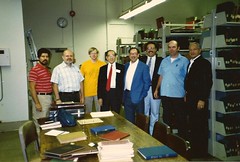
- Mark Auerbach
- George Kolbe
- Wayne Homren (me!)
- Frank Katen
- Ken Lowe
- Myron Xenos
- John Bergman
- Armand Champa
We had a great time at the Carnegie that day. I've lost touch with Mark Auerbach. George Kolbe and Myron Xenos are still very much with us, but the U.S. numismatic literature landscape is quite different today with the loss of Katen, Lowe, Bergman and Champa. I visited them all in their homes and offices on many occasions. I'm still in my 40s (by a hair's breadth), but I feel like an old timer in this hobby.
I'm sure many, if not most of today's E-Sylum subscribers never had the pleasure of knowing these dealers and collectors. Who has some thoughts they'd like to share? Send me your comments and I'll add some of my own for the next E-Sylum.
Here's another of Sam's photos from the 1989 convention. The ANA had a ceremony for the Western Pennsylvania Numismatic Society (WPNS). It was our club's 75th year as an ANA member, and we celebrated with a cake, seen on the table behind.
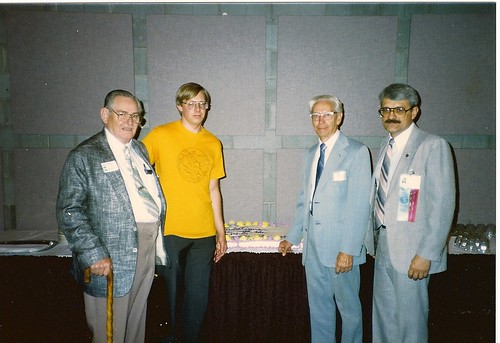
- Glenn Mooney
- Wayne Homren (me again!)
- Armor Murdoch
- Larry Korchnak
Armor and Glenn are gone now, too. Both were past presidents and longtime members of WPNS. Glenn was my closest numismatic mentor, and he sponsored my membership into the club. It's always sad to lose a fellow hobbyist, and the next item notes the loss of one of the giants of U.S. numismatics.
R.E. NAFTZGER, JR. 1925-2007
"Ted" Naftzger, as he was widely known, was a pre-eminent numismatist along the lines of Eric Newman in that his collecting interests extended back to the mid 1930s. His early contacts with major dealers like Abe Kosoff and Abner Kreisberg yielded many classic coin treasures and enabled him to build magnificent complete collections of early U.S. gold (it is said Ted owned two ultra-high relief $20's at one time), half cents and, I believe his first love, large cents. Ted had extensive financial interests in real estate and cattle ranches both foreign and domestic. But he was not always a wealthy man as he told me, over my kitchen table in 1996, that he had to take out a loan on his house to afford a complete collection of $10 and $20 gold pieces back in the late 1940's.
I distinctly recall him telling me that back about 1938 he ordered an 1867 rays proof nickel for around $100 from a major coin dealer in one of his first mail purchases. He received what he perceived to be an Unc and tried for an entire year to get a refund. He finally obtained it, but he never did business with that dealer again. The dealer fairly recently admitted to me his frustration in losing decades of profitable business with Ted.
Ted was a trusting gentleman. Stories abound. Rick Coleman, a half cent collector virtually unknown to Ted at the time, wrote to him inquiring about the availability of a particular pedigreed Unc 1793 half cent. Ted up and mailed him the half cent for examination, uninsured in a first class envelope! Apparently Ted's trust extended to the US Post Office! I personally had never done business with Ted before and knew him only by reputation when at 4PM New Year's Eve 1996 he drove out to my home, some 40 miles away, in a beat-up old station wagon. As he pulled up, I thought "Gee, can't the guy afford a newer car?" At my kitchen table as New Year's Eve events approached, he offered me a Gem Unc S-1 Chain cent (ex Tom Elder estate circa 1946 at $1000) and a choice AU S-1A cud Chain cent (ex-Garrett/Johns Hopkins University). This was in response to my classified ad in Penny-Wise, which has got to qualify as one of the most extraordinary opportunities to extend from a classified ad!
I couldn't afford them and declined. He offered me "terms" - Terms? What terms? Two years, no interest. No down payment! I couldn't refuse. My wife arrived home while Ted was still there and gave me the "evil eye" - "How much did you just spend?"
Ted & I shook hands, I accepted the coins and Ted was walking to the front door. "Wait a minute! Don't you want something in writing from me? No, I trust you." Stressing that something can happen to one of us, I gave Ted something in writing. Talk about trust!
But Ted's trust extended a bit too far in one historic transaction. In the 1970s, he bought Dr William H. Sheldon's large cent collection for about $300,000. It turned out that, decades later, many of the coins were discovered to have been switched out of ANS and probably some switched or stolen out of T. James Clarke's magnificent large cent collection and the Anderson Dupont large cents (both of which it is alleged Dr Sheldon "tampered" with).
Because Ted was such a serious "gotta have it" collector and perhaps because the ANS was advised of the switched large cents starting in 1973-74 and never pursued the issue for another two decades, Ted felt safe in retaining the coins and eventually selling many of the coins in one huge transaction in 1992 to Eric Steiner, then-youthful NYC dealer.
The coins were subsequently resold and traded into many different collections and the result was a years -long legal battle in civil court between the ANS and Ted and other innocent 3rd party collectors. This issue took a health and financial toll on Ted (approximately $1 million in costs) from which he would not recover.
But his name will live on with the likes of Mickley, Bushnell, Stickney, Dunham, Norweb, Garrett, Ford, Starr, Col. Green, Boyd and others.
To read the complete article, see: Roy E. Naftzger, Jr. 1925 - 2007 2002 Inductee
THE BOOK BAZARRE
DAVID SKLOW - FINE NUMISMATIC BOOKS now accepting consignments for our October 4th mail bid auction. numismaticbooks@aol.com (719) 302-5686, visit our web site www.finenumismaticbooks.com
 Publisher Finds Last Dozen Copies In
Move!
Publisher Finds Last Dozen Copies In
Move! This 1981 classic by Joseph Levine ... Collectors Guide To Presidential Inaugural Medals and Memorabilia... is long out of print. I found 12 copies in recent move. Auction records to $35!
Postpaid.............$23.00
Dick Johnson
139 Thompson Drive
Torrington, CT 06790
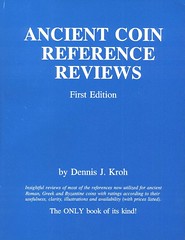 DAVID F. FANNING NUMISMATIC LITERATURE offers fixed
price lists on our Web site at www.fanningbooks.com. In stock:
Ancient Coin Reference Reviews. By Dennis J. Kroh. 1993. 4to., card
covers. New. A fantastic reference work rating and discussing hundreds of
numismatic references. $25 postpaid. e-mail dfanning@columbus.rr.com
DAVID F. FANNING NUMISMATIC LITERATURE offers fixed
price lists on our Web site at www.fanningbooks.com. In stock:
Ancient Coin Reference Reviews. By Dennis J. Kroh. 1993. 4to., card
covers. New. A fantastic reference work rating and discussing hundreds of
numismatic references. $25 postpaid. e-mail dfanning@columbus.rr.com
'COIN NEWS' OF THE UNITED KINGDOM IS NOW AVAILABLE ONLINE
- You can browse the magazine just as you would the paper version,
turning the pages by either "dragging" each one with your mouse or by
clicking on the arrows at the top!
- Alternatively the contents page is linked direct to all
features/articles - see something you'd like to read first? Go straight
to it with just one click!
- As well as all this every email address and website is "hot-linked" for you to be able to access it with just one click - see an advert you want to reply to? Click on the email! See a news piece and want more information? Click on the website address! It's that easy!
If you like what you see you can order a 12 month subscription to the digital magazine by emailing us on www.tokenpublishing.com!
MORE NOTES ON ERIC NEWMAN
For an advertising class in business school in 1957 I choose a real project instead of all my classmates' make-believe projects. I published a Numismatic Directory. I sent out questionnaires to coin dealers and numismatic organizations, hired Walter Breen to compile a list of all the world's numismatic periodicals and typed up all this data on a rented typewriter. The advertising I placed -- real ads! -- brought in hundreds of orders. I picked up the mail before attending this advertising class. I sat in the front row, right in front of the professor, opened this mail and removed hundreds of dollar bills.
But I needed a trademark for the directory. I asked Eric what coin I should use as a trademark. "An early American coin," he said. And he lent me one for my printer to photograph -- an 1793 half cent -- one of the first of the U.S. Mint. Eric was like that -- not only willing to share his knowledge and information, but also a coin from his extensive collection as well!
I had rented a third-floor apartment near WU campus. I brought my numismatic library there from Kansas City and filled the shelves with these books and books I purchased during the years I attended college. Eric visited my apartment occasionally and our conversations were all on numismatic books. We spread books on the [sparse] furniture and floor as we talked and handled the volumes. He has often told me his intense interest in numismatic literature sprang from these book sessions.
I could recount many other occasions, but wherever I went in numismatics and whatever I did, Eric Newman could always be counted on for wise advice and excellent numismatic knowledge. How fortunate his collections are now housed in a new museum on the Washington University campus. His knowledge will continue to be disseminated for all who seek it as it has in the past. I salute Eric Newman as the great numismatist, researcher, author and numismatic bookman he is on his 97th birthday!
Barbara Gregory, editor of The Numismatist writes:
I was in my bathrobe on Sunday morning, in the middle of pouring pancake batter on the griddle, when the telephone rang. Eric wanted to talk about a few items. I explained I didn¹t have his manuscript at hand and suggested we discuss the article on Monday, but he insisted on taking advantage of the moment. We settled his minor issues in about 15 minutes, and the article went on to win a Heath Literary Award.
By the way . . . Eric recently penned a short poem, "Ode to a Bibliophile," for retiring American Numismatic Society Librarian Frank Campbell. THE NUMISMATIST plans to share it with readers in the "Letters" section of the July 2008 issue.
MORE ON THOSE OBVERSE MARKS ON A FEW 1794 DOLLARS?
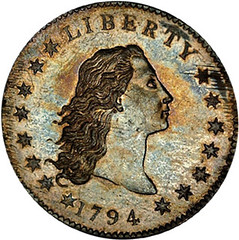 Andy Lustig writes: "Regarding Alan Weinberg's
question concerning the small marks seen on some 1794 Dollars, my
suspicion is that they were caused by the removal of planchet inclusions,
probably in a batch treatment at the Mint. I suspect that the process
involved burning out the inclusions with either heat or an acid bath of
some sort, but I'm just guessing."
Andy Lustig writes: "Regarding Alan Weinberg's
question concerning the small marks seen on some 1794 Dollars, my
suspicion is that they were caused by the removal of planchet inclusions,
probably in a batch treatment at the Mint. I suspect that the process
involved burning out the inclusions with either heat or an acid bath of
some sort, but I'm just guessing."Dave Lange writes: "To me this description seems to fit the test marks frequently seen on old silver coins up through the Seated Liberty period. These depressions were supposedly made deliberately in a test of the coins' hardness on the theory that a base-metal counterfeit would be much softer than a genuine coin of alloyed silver. I've seen them on other dates of early dollars and halves, though rarely on the smaller silver."
Coin image from CoinFacts.com; to read the CoinFacts page on the 1794 dollar, see: Flowing Hair Silver Dollars
To read the original E-Sylum article, see: JUST WHAT ARE THOSE OBVERSE MARKS ON A FEW 1794 DOLLARS?
QUERY: WHAT IS THE SIGNIFICANCE OF ROYAL MINT DIE NUMBERS?
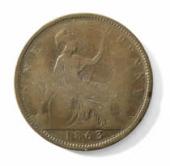 A rare English penny has been sold at auction in
North Yorkshire for a record-breaking £17,500.
A rare English penny has been sold at auction in
North Yorkshire for a record-breaking £17,500.The number five die coin, which dates back to 1863, was bought by a private collector from Scotland last week as part of a £176,000 sale at Tennants Auctioneers, Leyburn.
Thought to be the only one of its type in existence, the coin had been stamped with a die number below the date, a practice introduced by the Mint in the 1860s for unknown reasons.
Die numbers two, three and four have already been found, but a number five die penny has never been recorded until now.
The penny was inspected by Royal Mint authorities, including the chief engraver, who shared the view that the figure beneath the date was indeed a five.
Jeff Gardiner, of Tennants Auctioneers, said: "There were reports of another number five die coin about 20 years ago, but we agree that this was probably that same coin and that in fact there is only one in existence.
Image from AuctionPublicity.com. To view the complete press release, see: Unique, Unrecorded 1863 Penny turns up
To read the complete article, see: Rare coin sells for £17,500
I pulled off the shelf my copy of Spink's Coins of England and the United Kingdom (41st edition, 2006). On p404, in the preface to the section on the coins of Queen Victoria (1837-1901), the author states:
THE JOB BAZARRE
QUERY: DON TAXAY COIN WORLD ARTICLE SOUGHT
Paul Withers writes: "A friend of mine, a non-computer user, but a serious numismatist of the last generation, living in France, writes to me to ask how he might obtain a photocopy of an article that appeared in Coin World. The article was by Don Taxay on the St Patrick Coinage and appeared on November 8th, 1978."He is anxious to get hold of this article, and it doesn't seem to be available anywhere in France, and I have tried here in the UK, with no result. Can any of your readers help, please ? Coin World seems to have an internet archive, but only for things published since 2001. Thank you."
U.S. MARINE IN IRAQ SUSPENDED OVER TOKENS QUOTING GOSPEL
So here's a challenge for E-Sylum readers: can anyone manage to track down and obtain an example of the token? Perhaps they'll be all over eBay; then again, we may never hear of them again. It would be great to at least get examples for numismatic museums here in the U.S. -Editor.
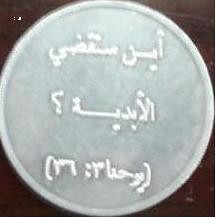 The U.S. military suspended a Marine on
Thursday for distributing coins quoting the Gospel to Sunni Muslims, an
incident that has enraged Iraqis who view it as the latest example of
American disrespect for Islam.
The U.S. military suspended a Marine on
Thursday for distributing coins quoting the Gospel to Sunni Muslims, an
incident that has enraged Iraqis who view it as the latest example of
American disrespect for Islam. The Marine, stationed in the western city of Fallujah, handed out silver-colored coins this week that said in Arabic: "Where will you spend eternity? (John 3:36)." The other side read: "For God so loved the world that he gave his only begotten son, that whoever believes in him shall not perish but have eternal life (John 3:16)."
"We are sorry for this behavior," said Mike Isho, a U.S. military spokesman in Anbar province, which includes Fallujah. He said the Marine, whom he did not identify, distributed only a few of the coins and that the episode was under investigation.
Mohammed Amin Abdel-Hadi, the head of the Sunni Endowment in Fallujah, an institution responsible for overseeing the sect's mosques, criticized U.S. troops, whom many in the city view as occupiers, for acting like Christian missionaries. He said the coins were part of a pattern of insensitivity toward Muslims...
"We demand the Americans leave us alone and stop creating religious controversies," Hadi said. "First, they shot the Koran, and now they come to proselytize inside Fallujah."
Mohammed Jassim al-Dulaimi, 43, said a Marine forced one of the coins into his hand Tuesday morning as he passed through a checkpoint at the western entrance to Fallujah. He said he was shocked when he read it.
"The claims that the occupation is a Crusader War make sense now," Dulaimi said.
Police were placed on high alert and deployed around Fallujah's mosques. Officials feared violence after Friday prayers, when imams are expected to rail against the distribution of the coins and the shooting of the Koran, said police Capt. Ahmed al-Jumaili. He added that U.S. troops had reduced their presence on the streets of the city.
To read the complete article, see: Marine in Iraq Suspended Over Coins Quoting Gospel
To read the original story from the McClatchy newspapers, see:
UNUSUAL COIN FOUND ON FLORIDA BEACH
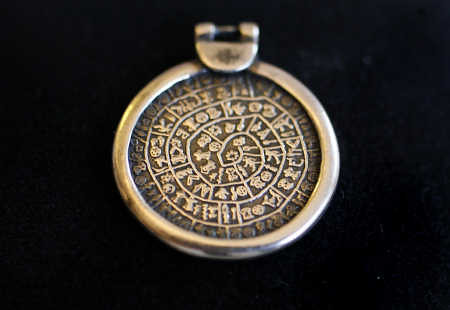
To read the complete article, see: Port Richey treasure hunter has uncanny knack
TOP INVESTOR STARTED BY BUYING SILVER DOLLARS
Just how good has Heebner been? We may well be witnessing the most dazzling run of stock picking in mutual fund history. Since May 1998, Focus has an average annualized return of 24%, the best ten-year record of any U.S. mutual fund...
Even more remarkable than the raw numbers is how Heebner has earned them. Heebner is a true contrarian, who says he's most confident as an investor "when everyone else thinks I'm nuts." He works long hours trying to identify emerging trends in the economy. When he finds a promising one, he'll go all in, making huge bets on the stocks poised to benefit. Asked how long it takes him to identify those stocks, Heebner answers, "About ten minutes. I've been at this a long time." It's an investing style that will never be taught in business schools and is definitely not something any amateur should try at home. But Heebner, blessed with uncanny instincts, has managed to see around just about every corner in a market that has befuddled just about everyone else.
"Ken did march to his own drumbeat, but he was absolutely brilliant. I never, ever doubted that he was going to be a great investor." Henry, himself a long-time shareholder in Heebner's funds, says what first impressed him about Heebner was a little gambit he had going in finance class. Classmates would bring him silver dollars, which Heebner would exchange for dollar bills. Says Henry: "Ken was hoarding silver dollars on the idea that silver was going to keep appreciating, which would eventually force the Treasury to stop issuing new silver coins." And that's exactly what happened. "It was funny as hell - he'd be sitting there with piles of silver dollars on his desk - but Ken had it nailed," Henry says. "He saw something the rest of us didn't. That's Ken - that's always been Ken."
Asked about the silver dollars, Heebner smiles and reveals that it was more than a lark for him. At one point he'd accumulated 13,000 silver dollars and had even taken out a bank loan to help finance his little venture. "The Treasury had these uncirculated silver dollars in bags in vaults. You could walk in with a thousand dollars, and they'd give you a bag of 1,000 silver dollars." It's still the best deal he's ever seen, he says: "You couldn't lose, but you could make a lot." Heebner figures he eventually netted around $15,000, but he was less successful when he tried to parlay his experience into a term paper about why silver prices were going up: "I didn't get a very good grade."
To read the complete article, see: America's hottest investor
WALL STREET JOURNAL ON USED MEDALS FROM THE OLYMPIC DOPING SCANDALS
"I got the shock of my life," says the Bahamian runner, now 41 years old. "I just sat there staring at the television with my mouth wide open." The crackdown on doping in sports is turning some losers into overnight winners. The Marion Jones case alone could bump up 29 athletes, either within the medalist standings or into them. But for the newly minted winners, it's not always a cause for celebration. Wrenching an award from one athlete and handing it off to another is often a long and tortured process. Evidence can take months to surface and appeals can go on for years; some people simply refuse to send their medals back.
French runner Muriel Hurtis might hold the record for inherited medals. The first time a doping scandal bumped her up the rankings -- from a bronze to a silver in the 400-meter relay at the 2001 International Association of Athletics Federations World Championships -- Ms. Hurtis says she was "pleased." The second time, she received a makeshift ceremony a year after the original race. The third time, when a silver medal turned to gold, she was on maternity leave.
Of course, athletes rarely demur when offered a gently used medal. After all, a gold medal can be a career-changing event no matter when it's received. It is one of the highest honors in sports and a status symbol that can open doors both socially and professionally.
But medal redistributions are frequently marred by bitterness and delayed by red tape. The IAAF, which organizes world championships, says only 10% of disqualified athletes actually return their medals. "We have no legal powers to demand or raid someone's home to get a medal back," says Chris Butler, a spokesman.
Marion Jones has already returned the five medals she won in 2000, including three golds and two bronzes, to the International Olympic Committee. But the redistribution of her medals -- the largest for any one athlete in Olympic history -- has yet to be carried out.
In some cases, reversals can be reversed, meaning athletes win, lose, then win again. After being disqualified for doping at the 2004 Athens Olympics, María Luisa Calle, a Colombian cyclist, was forced to surrender her bronze medal. The IOC then passed the medal on to American Erin Mirabella, who had placed fourth in the event. Ms. Mirabella's friends later surprised her with a small medal-awarding ceremony in the restaurant of the Breckenridge, Colo., lodge where she was vacationing.
Medals have been awarded at the Olympics since the first modern Games in Athens in 1896.
To read the complete article, see: Doping Scandals Make Winners of Olympic Losers
NEW METALS FOR COINS AND MEDALS MANUFACTURED IN SPACE?
For example, heavy-weight gold and light-weight aluminum, can NOT be alloyed on earth (such metals are called noncompatible alloys by metallurgists). If this could be accomplished in space it would result in a new metal with who-knows-what characteristics. Perhaps such an alloy would be high value, gold color, low weight. That might be an ideal coinage metal! It would certainly be an excellent composition for a space medal. Imagine what could be designed for such an exciting issue. Despite the popularity of the term "nickel-silver" there is no silver in nickel-silver as nickel-silver is actually an alloy of nickel, copper and zinc. Nickel and silver are noncompatible metals, they cannot be alloyed together.
The combination of two traditional coinage metals into one new composition is guaranteed to be a winner for a new coin alloy. It might also have some features we cannot even dream of here on earth. Strike that alloy in a new $10 coin. Once enough of the space-made alloy could be brought back to earth we could strike these into coins. Until then the first shipment of that rare alloy should be made into a special medal honoring American technology in space. That's an achievement! Please line up behind me. I want to be the first buyer of that medal, no matter what the price.
THE CASE OF THE BOGUS BORDEAUX
The twisted saga of how the Jefferson bottles first enthralled and then shamed the world of fine wine is the subject of Benjamin Wallace's fascinating The Billionaire's Vinegar: The Mystery of the World's Most Expensive Bottle of Wine. With plenty of detail, richly quirky characters, and restrained pacing, Wallace introduces us to the rarefied world of high-end wine. Part detective story, part wine history, this is one juicy tale, even for those with no interest in the fruit of the vine.
At the center of the story is Hardy Rodenstock, a secretive German manager of pop bands with an uncanny knack for ferreting out very old bottles of fine French wine—especially those predating the phylloxera epidemic that decimated European grape vines in the late 1800s. Not only was Rodenstock a whiz at finding scarce 18th and 19th century bottles, he could unearth them in the rare, oversize bottles (magnums or jeroboams, for instance) most prized for their aging potential. "It seemed strange that the bottle hunter raising his shovel in triumph was invariably Hardy Rodenstock," Wallace writes.
How could this happen to so many people who should have known better? Wallace blames it on the all-too-human desire to possess something that others cannot. To be able to quaff a vintage chosen by early America's greatest statesman and foremost connoisseur is something only a few can hope to experience. And that tantalizing bait made these well-heeled oenophiles almost-too-willing victims. "As with all successful cons, the marks and grifter had been collaborators," writes the author. "One sold the illusion that the others were desperate to buy." Luckily for readers, Wallace has made the unmasking of this deceit as delicious as a true vintage Lafite.
To read the complete article, see: The Case of the Bogus Bordeaux
U.S. MINT EMPLOYEE DISCIPLINED FOR PUTTING OWN FACE ON NICKELS
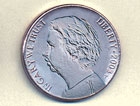 Arthur Shippee forwarded this amusing
illustration from the online satire magazine, The Onion.
Arthur Shippee forwarded this amusing
illustration from the online satire magazine, The Onion.To view the original article, see: U.S. Mint Employee Disciplined For Putting Own Face On Nickels
FEATURED WEB SITE: GERMAN NOTES
This week's featured web site is GermanNotes.com.
Find out about German Paper Money, history and facts about German banknotes and their historical context. A vast amount of banknotes have been issued in Germany and its regions. They are a mirror of German history, culture and politics.
http://www.germannotes.com/
